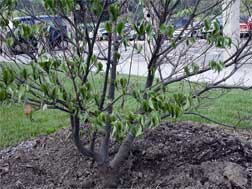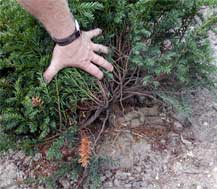Scouting for abiotic diseases: Improper planting depth
Editor’s note: This article is from the archives of the MSU Crop Advisory Team Alerts. Check the label of any pesticide referenced to ensure your use is included.
When planting, look for the root flare, and plant the ball with the root flare level with the ground. The kousa dogwood in Photo 1 declined over a period of several years before it died.
In Photo 1, the root flare was buried 5 inches down and topped with a layer of mulch. Be careful when uncovering roots of plants that have been buried for several years. Many roots have developed near the surface. These roots can be killed when uncovered. Adjusting planting depth is best done in spring after the weather settles to allow time for new root growth to develop and to allow the plant to adjust before the ground freezes.
Symptoms associated with planting too deep include wilting, stunted growth, chlorosis, dieback, early fall color, scorch and the development of adventitious roots. Planting too deep restricts the amount of water and oxygen to the fine root systems, lowering the trees vitality. Trees planted too deep are also more subject to canker development and wind throw.
This information was from A Pocket IPM Scouting Guide for Woody Landscape Plants.
Planting too shallow can also be problematic. This yew (Photo 2) was planted with part of the root ball sticking out of the ground, and the burlap and twine left on. Burlap should be removed if possible or at least cut off the top to allow water penetration into the root ball. Twine should be removed. The root ball should be just covered with soil.



 Print
Print Email
Email





